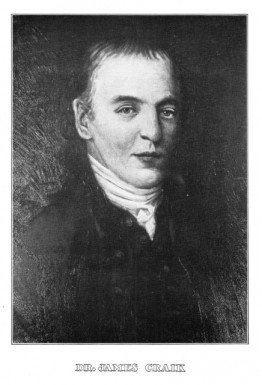 Dr. James Craik was born in the parish of Kirkbean, County Kirkcudbright, near Dumfries in Scotland in July of 1730. Craik was the son of William Craik, a member of the British Parliament and the laird of Arbigland, a 1,400-acre estate on the Firth of Solway on the west coast. Despite Craik being born out of wedlock, his father acknowledged his son, providing care and an education. The younger Craik pursued medical training at the University of Edinburgh and provided medical service to the British army upon graduation.
Dr. James Craik was born in the parish of Kirkbean, County Kirkcudbright, near Dumfries in Scotland in July of 1730. Craik was the son of William Craik, a member of the British Parliament and the laird of Arbigland, a 1,400-acre estate on the Firth of Solway on the west coast. Despite Craik being born out of wedlock, his father acknowledged his son, providing care and an education. The younger Craik pursued medical training at the University of Edinburgh and provided medical service to the British army upon graduation.
In 1750, James Craik immigrated to the West Indies to serve as an army surgeon. Soon after, however, he resigned his post and moved to Norfolk, Virginia where he opened a medical practice. Craik later moved to the frontier town of Winchester, practicing as a surgeon based at Fort Loudon. In March of 1754, Craik joined the Virginia Provincial Regiment and remained as unit surgeon until the regiment was disbanded in 1762.
Craik served with the regiment during what has become known as Braddock's Defeat, a failed British attempt to conquer the French-held Fort Duquesne in 1755. Craik treated Braddock's wounds until the general's death the next day. It was in this capacity that Craik met George Washington, who commanded the regiment from 1755 until 1758. Washington was given the task of protecting the Virginia and Maryland hinterlands and Craik served as the group's chief medical officer until 1756. Upon retirement from the army, Craik purchased a plantation at Port Tobacco, Maryland and began a new medical practice.
Craik and Washington's relationship continued to grow following their military service. In 1770, Craik accompanied Washington on a westward journey to the Ohio River Valley to view lands deeded to Washington as a result of his service in the French and Indian War. Fourteen years later in 1784, Craik and Washington took a similar trip to observe more of Washington's western lands.
Craik took an early, active interest in the push towards American independence, eventually serving closely with Washington as Assistant Director General of the Middle Department of the Continental Army in 1774. Four years later, in 1778, Craik warned Washington of the burgeoning "Conway Cabal" that sought to replace Washington as Commander-in-Chief with Horatio Gates. Craik eventually rose to the second highest medical post in the army, where he served until the close of the war.
 After the war's conclusion, Craik opened a medical practice in Alexandria, Virginia, and visited Mount Vernon frequently, serving as Washington's personal physician. In 1798, with Washington briefly called from his retirement to command the army in preparation for a possible war with France, Craik was named his chief medical officer. With war averted, Craik continued his medical practice in Alexandria.
After the war's conclusion, Craik opened a medical practice in Alexandria, Virginia, and visited Mount Vernon frequently, serving as Washington's personal physician. In 1798, with Washington briefly called from his retirement to command the army in preparation for a possible war with France, Craik was named his chief medical officer. With war averted, Craik continued his medical practice in Alexandria.
On December 13, 1799, Craik was summoned to Mount Vernon to attend to a gravely ill Washington. Serving with two other doctors, Craik repeatedly attempted to cure what ailed the sickly former president. Washington passed away the next day, despite the best efforts of his long time friend and physician. Craik lived the rest of his life in Alexandria where he passed away in 1814 and was buried in the cemetery of the Old Presbyterian Meeting House.
Adam D. Shprintzen, Ph.D.
Marywood University
Bibliography:
Duncan, Louis C. Medical Men in the American Revolution, 1775-1783. Carlisle Barracks, PA: Medical Field Service School, 1931.
Pilcher, James Evelyn. The Surgeon Generals of the Army of the United States of America: A Series of Biographical Sketches of the Senior Officers of the Military Medical Service from the American Revolution to the Philippine Pacification. Carlisle, PA: Association of Military Surgeons, 1905, 21–24.












 Dr. James Craik was born in the parish of Kirkbean, County Kirkcudbright, near Dumfries in Scotland in July of 1730. Craik was the son of William Craik, a member of the British Parliament and the laird of Arbigland, a 1,400-acre estate on the Firth of Solway on the west coast. Despite Craik being born out of wedlock, his father acknowledged his son, providing care and an education. The younger Craik pursued medical training at the University of Edinburgh and provided medical service to the British army upon graduation.
Dr. James Craik was born in the parish of Kirkbean, County Kirkcudbright, near Dumfries in Scotland in July of 1730. Craik was the son of William Craik, a member of the British Parliament and the laird of Arbigland, a 1,400-acre estate on the Firth of Solway on the west coast. Despite Craik being born out of wedlock, his father acknowledged his son, providing care and an education. The younger Craik pursued medical training at the University of Edinburgh and provided medical service to the British army upon graduation. After the war's conclusion, Craik opened a medical practice in
After the war's conclusion, Craik opened a medical practice in